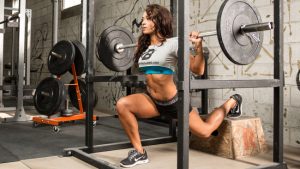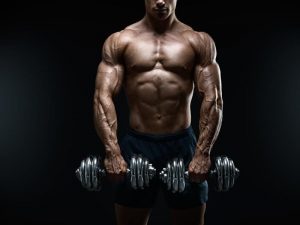Nutritional Features of Power Sports Representatives
Although bodybuilding has traditionally been combined with weightlifting and powerlifting , there are significant differences in the diet of bodybuilders.
In the off-season, an athlete can actively increase body weight, mainly through muscles to increase strength or move to the next weight category. For bodybuilders, an intense fat loss before competition is also a must.
During the period of performances, security officials need to provide the muscles with the necessary macro – and microelements for the development of maximum effort. Again, a bodybuilder on the podium is not obliged to demonstrate miracles of strength, but he will have to very finely regulate the composition of the diet so that the hard-won muscles are visible in all details.
Basic dietary requirements
The calorie content is increased – especially during the period of weight gain. The average caloric content of the daily diet of weightlifters should be 3500–4500 kcal for men (70 kg) and 3000–4000 kcal for women (60 kg). During the period of intense training and weight gain, the calorie content in strength forms for men is 4200-5100 kcal with the following ratio of the main nutrients: proteins – 18-20%, fats – 31-32%, carbohydrates – 49-50%.
In any case, one should approach the question of the calorie content of the diet strictly individually. Especially carefully calculations should be made for bodybuilders – to the point that an athlete must weigh each piece eaten and sit for a long time with a calculator and calorie tables. On the other hand, during the period of weight gain, athletes eat everything, caring only about protein. Naturally, this approach gives very dubious results: first, the muscles are overgrown with a huge amount of fat, and then this fat is long and painfully driven off.
Ordering steroid central uk is easy – you need to place your order at a specialist online pharmacy and then confirm it.

Planning the diet of the security officer
At the beginning, the calculation of energy consumption is carried out taking into account the basic metabolism. In those cases when a particularly accurate calculation of calories is required, self – type is also taken into account – a general characteristic of the physique. Ectomorphs (naturally thin, with thin bones and long limbs) have a slightly accelerated basal metabolism compared to mesomorphs (proportionally folded, naturally strong). All other things being equal, they require 5-6% more calories than is obtained by the formula. On the contrary, in endomorphs(people of dense build, with a wide skeleton, prone to overweight), the basal metabolic rate is somewhat slowed down, and they need 5-6% less compared to the calculated one. In this case, most often there are mixed types of physique, for which the required number of calories, ensuring the maintenance of the basic functions of the body, is selected individually.
For some time, you should record in the diary all the food you eat and calculate its calorie content according to tables taken, for example, from culinary reference books. Thus, the approximate calorie content of the daily diet and the content of nutrients in it will be obtained . Then, by changing the composition of food, you should achieve the desired result. After an approximately optimal layout has been found, accurate calculations will no longer be needed, since the body’s need for food fluctuates within fairly wide limits. Each diet option (for gaining mass, for losing fat) requires about 14 to 30 days of careful monitoring; then you can regulate the intake of nutrients, almost without looking at the tables.
First of all, it is high in protein , since strength training leads to an accelerated restructuring of muscle tissue. However, how many are needed?
Protein is one of the most controversial issues in sports nutrition. Some athletes believe that an adult should receive 11-13% of the daily calorie intake from proteins (both animal and vegetable – in approximately equal proportions), foreign sports nutritionists – about 20%.
However, even diehard low-protein diets acknowledge that high-intensity athletes should get more protein than the average person.
Protein is the least valuable source of energy, however, excess protein can slow recovery and convert extra calories to fat. In addition, if protein is used as an energy source, some of the calories are spent on the absorption process itself (20-30%). The breakdown of amino acids and their conversion into carbohydrates or burning as an energy source is accompanied by the release of gases with a pungent unpleasant odor – toxic ammonia and sulfur compounds, which not only spoil the air, but also lead to self-poisoning of the body.
During the period of weight gain, an athlete needs about 2 g of protein per 1 kg of body weight per day, and sometimes up to 3 g (however, you should not consume such amounts constantly – for the reasons stated above).
Carbohydrates, as the main source of energy, should make up a significant part of the food consumed. With a low-fat diet, you should pay attention to the fact that the ratio of carbohydrates and proteins in food is at least 2: 1 – otherwise, problems with the absorption of the latter are possible. With sufficient fat intake, a 4: 3 ratio is quite sufficient (by weight, since the calorie content of 1 g of proteins and 1 g of carbohydrates, even taking into account different energy costs for their assimilation, is approximately the same).
Fat intake can be up to 35% of the total calories, but most of them (at least 2/3) should be unsaturated fat. Lack of fats in food leads to the fact that the body begins to save them, and the rate of lithogenesis sharply decreases. Therefore, you need to track the body’s response to excess and lack of fat.
An increase in protein content in food is associated with the need to increase the volume of drinking water, since this allows you to cleanse the body of harmful metabolites. Although the water regimen in strength sports is not as critical as with very long loads (such as cross-country and bicycle races), you should still drink about 2 liters of fluid per day (excluding coffee and tea).
With a very high calorie diet, the body receives an excess of salt – especially when eating in a restaurant. Therefore, it makes sense to monitor the salt balance, limiting sodium intake (to avoid edema ), as well as the intake of other minerals (lack of zinc , magnesium , potassium and calcium leads to serious disorders in the body and decreased performance).
For bodybuilders, excess sodium is also detrimental because it causes fluid retention and muscles float in water. However, over-restricting sodium intake causes electrolyte imbalances, which can damage the heart and brain.
Weightlifters tend to train for a short time compared to other sports. Powerlifting training can last 3-4 hours. Bodybuilders do not often divide training into two parts – morning and evening.
Since the intensity of loads in strength forms is very high, a rather long break between meals and training is required – 1–1.5 hours. After training, a certain amount of proteins and carbohydrates must be consumed for 1.5 hours to compensate for the costs of building muscles. During this period, the so-called “protein window” opens and the need for amino acids sharply increases.
On the other hand, heavy exercise often causes a decrease in appetite. And yet, after training, you need to eat about an hour later to get into the “window”. Usually the body itself gives a signal that it is time to “refuel”.
In any case, a hearty dinner may be superfluous. The last meal should be divided into two parts (in a ratio of about 2: 1), with an emphasis on protein.
Food supplements are most widely used in bodybuilding and strength training. The most commonly used proteins and amino acids . It is necessary to plan the intake of protein-carbohydrate and amino acid preparations in accordance with the training objectives and the composition of the diet. You should not get carried away with individual amino acids: they should complement and balance nutrition , not replace it.
It is necessary to reasonably relate to the choice of vitamin-mineral complexes and observe moderation in dosages.
Creatine , which has been proven to be effective for many years in various sports, is sometimes included in proteins . However, it should be consumed separately – for a more accurate dosage. The most convenient capsules for use. The liquid form can also be used, although the greater effectiveness of taking creatine solutions compared to powder has not yet been proven.
Recommended supplements: Proteins, creatine, monohydrate , multivitamins and minerals, amino acids (in moderation).

The method of gaining body weight
The main patterns of building a method for gaining mass primarily provide for the growth of muscles. In strength sports, it is sometimes necessary to increase the mass to move to a heavier weight category, while it is still desirable that most of the gain is muscle, not fat.
Bodybuilders, on the other hand, build up muscles without restrictions, since now victory in competitions is primarily determined by the volumetric characteristics of the muscles.
To build muscle, you need protein (about 220 g per 1 kg of planned gain) and energy (about 990 calories). Therefore, when gaining weight, you need to increase mainly your protein intake. The amount of fat will also increase. For security officials, this is not so scary, although you should try to ensure that most of the added fats are unsaturated ( fish oil , vegetable oils). Bodybuilders usually try to avoid obesity by switching to a low-fat diet, but it is nowhere near as effective as a diet with a reasonable intake of unsaturated fats.
In order to build up exactly the muscles, experts recommend limiting the set of muscles to 1–2 kg per month. This means adding only 33–66 calories to your daily calorie intake (about 40–70 calories after taking into account losses).
When losing fat, you must avoid catabolism, i.e. muscle breakdown and dehydration. As stated, 1 kg of fat is equivalent to approximately 7,710 calories. Losing fat is also recommended at a moderate pace, but not all bodybuilders and weightlifters follow this rule. As a result, the athlete not only loses a significant amount of muscle (and, therefore, sharply decreases his strength), but also drains vital tissues (brain, heart, liver).
To remove 1 kg of fat per month, the body will have to lose about 257 calories daily compared to the estimated need.
Accordingly, dropping 2 kg per month means “not getting” about 514 calories per day. For ectomorphs, the restrictions should be less severe, since they have a greater risk of developing catabolism. It is not recommended to drastically lose weight due to liquid. Bodybuilders before the competition sometimes bring themselves to the state of mummies with the help of diuretics (diuretics), which is very dangerous.
The following diet options are designed to provide athletes with all the nutrients they need.
Diet for fast weight gain
- Breakfast: scrambled eggs from 2-3 eggs or soft-boiled eggs; a plate with vegetable oil; 1 fruit (any).
- Second breakfast: 200 g of meat or fish; a plate of rice; a glass of yogurt or kefir.
- Lunch: 200 g of meat; a bowl of soup; 300 g potatoes or rice; vegetable salad.
- Afternoon snack: 200 g of meat or cottage cheese; a plate of rice or boiled corn; 1 fruit.
- Dinner: 200 g of boiled meat; 300 g potatoes; salad; a cup of milk.
- 1.5-2 hours before bedtime: 2 soft-boiled eggs; omelet or cottage cheese; a serving of vegetable cream or some bread.
Diet for weight loss
- Breakfast: egg whites omelet or 200-300 g of cottage cheese; 2 servings of vegetable cream or pasta.
- Second breakfast: 160 g of meat; a plate of rice; vegetables.
- Lunch: 180 g of meat, fish or poultry; 220 g potatoes (or a plate of boiled peas); a plate of salad.
- Afternoon snack: a pack of cottage cheese or 160 g of meat; a plate of rice; vegetables or fruits.
- Dinner: 160 g of meat; 280 g potatoes; salad.
- 1.5-2 hours before bedtime: egg whites omelet or ½ pack of cottage cheese; a serving of vegetable cream or noodles.
The main requirement is variety. Bodybuilders need to stop feeding themselves egg whites and chicken and rice. The product combination options are countless. However, it is necessary to monitor their compatibility: do not eat fish and milk, dairy products (except sour cream) and legumes in a row (and even more so together). Perhaps everyone has their own combinations of foods to which the body reacts inadequately.

